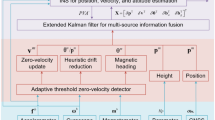Abstract
Indoor tracking systems have become very popular, wherein pedestrian movement is analyzed in a variety of commercial and secure spaces. The inertial sensor-based method makes great contributions to continuous and seamless indoor pedestrian tracking. However, such a system is vulnerable to the cumulative locating errors when moving distance increases. Inaccurate heading values caused by the interference of body swing of natural walking and the geomagnetic disturbances are the main sources of the accumulative errors. To reduce such errors, additional infrastructure or highly accurate sensors have been used by previous works that considerably raise the complexity of the architecture. This paper presents an indoor pedestrian tracking system called WTrack, using only geomagnetic sensors and acceleration sensors that are commonly carried by smartphones. A fine-grained walk pattern of indoor pedestrians is modeled through Hidden Markov Model. With this model, WTrack can track indoor pedestrians by continuously recognizing the pre-defined pedestrians’ walk pattern. More importantly, WTrack is able to resist both the interference of body swing of natural walking and the geomagnetic disturbances of nearby objects. Our experimental results reveal that the location error is <2 m, which is considered adequate for indoor location-based-service applications. The adaptive sample rate adjustment mode further reduces the energy consumption by 52 % in comparison, as opposed to the constant sampling mode.













Similar content being viewed by others
References
Zhang B, Chen K, Cheng Y et al (2012) Location-log: bringing online shopping benefits to the physical world with magnetic-based proximity detection. In: Proceedings of ACM/IEEE IPSN, pp 1–5
Hong F et al (2012) Pocket mattering: indoor pedestrian tracking with commercial smartphone. In: International conference on indoor positioning and indoor navigation, vol 13
Jin Y et al (2011) A robust dead-reckoning pedestrian tracking system with low cost sensors. In: Proceedings of IEEE PerCom, pp 222–230
Bahl P, Padmanabhan VN (2000) RADAR: an in-building RF-based user location and tracking system. In: Proceedings of IEEE PerCom, pp 775–784
Yang Z, Wu C, Liu Y (2005) Locating in fingerprint space: wireless indoor localization with little human intervention. In: Proceedings of ACM MobiCom, pp 269–280
Rai A et al (2013) Zee: zero-effort crowdsourcing for indoor localization. In: Proceedings of ACM MobiCom, pp 293–304
Li F, Zhao C et al (2012) A reliable and accurate indoor localization method using phone inertial sensors. In: Proceedings of ACM UbiComp, pp 421–430
Lee S et al (2013) Smartphone-based indoor pedestrian tracking using geo-magnetic observations. In: Mobile Information Systems, pp 123–137
Harle R (2013) A survey of indoor inertial positioning systems for pedestrians. IEEE Commun Surv Tutor 15(3):1281–1293
Faulkner WT et al (2010) GPS-denied pedestrian tracking in indoor environments using an imu and magnetic compass. In: Proceedings of ITM, pp 198–204
Constandache I et al (2010) Towards mobile phone localization without war-driving. In: Proceedings of IEEE INFOCOM, pp 1–9
Steinhoff U, Schiele B (2010) Dead reckoning from the pocketan experimental study. In: Proceedings of IEEE PerCom, pp 162–170
Woodman O, Harle R (2008) Pedestrian localization for indoor environments. In: Proceedings of ACM UbiComp, pp 114–123
Hsiao R, Schultz T (2011) Generalized Baum-Welch algorithm and its implication to a new extended Baum-Welch algorithm. In: Proceedings of INTERSPEECH, pp 773–776
Huang Z, Chang Y, Long B, Crespo JF, Dong A, Keerthi S, Wu SL (2012) Iterative Viterbi A* algorithm for k-best sequential decoding. In: Proceedings of 50th annual meeting of the association for computational linguistics (ACL), pp 611–619
Chung J, Donahoe M, Schmandt C, Kim IJ, Razavai P, Wiseman M (2011) Indoor location sensing using geo-magnetism. In: Proceedings of ACM MobiSys, pp 141–154
Evennou F, Marx F (2006) Advanced integration of WiFi and inertial navigation systems for indoor mobile positioning. EURASIP J Appl Sig Process 2006:164
Guo J et al (2013) Square-root unscented Kalman filtering-based localization and tracking in the internet of things. Pers Ubiquit Comput. doi:10.1007/s00779-013-0713-8
Robertson P, Angermann M (2009) Simultaneous localization and mapping for pedestrians using only foot-mounted inertial sensors. In: Proceedings of ACM UbiComp, pp 93–96
Youssef M, Agrawala AK (2005) The Horus WLAN location determination system. In: Proceedings of ACM MobiSys, pp 205–218
Shen G et al (2013) Walkie-Markie: indoor pathway mapping made easy. In: Proceedings of USENIX NSDI, pp 85–98
Feliz R et al (2009) Pedestrian tracking using inertial sensors. J Phys Agents 3(1):35–42
Gusenbauer D et al (2010) Self-contained indoor positioning on off-the-shelf mobile devices. In: International conference on indoor positioning and indoor navigation, pp 1–9
Park K et al (2013) Smartphone-based pedestrian tracking in indoor corridor environments. Pers Ubiquit Comput 17(2):359–370
Jin Y et al (2013) A robust indoor pedestrian tracking system with sparse infrastructure support. IEEE Trans Mob Comput 12:1392–1403
Lee W, Jung P, Song H (2013) Hybrid indoor location tracking for pedestrian using a smartphone. Robot Intell Tech Appl 208:431–440
Link J, Smith P, Viol N et al (2011) Footpath: accurate map-based indoor navigation using smartphones. In: International conference on indoor positioning and indoor navigation, pp 1–8
Acknowledgments
This work was partially supported by the National Key Basic Research Program of China “973 Project” (Grant No. 2011CB707106), the National High-Tech Research and Development Program of China “863 Project” (Grant No. 2013AA122301), the Program for Changjiang Scholars and Innovative Research Team in University (Grant No. IRT1278), the National Natural Science Foundation of China NSFC (Grant No.F020201, 61070013, 61250110541, U1135005, 61303212), “Hundred Talents Recruitment Program” of Global Experts of Hubei, and the US National Science Foundation (Grant No. CNS-1136027).
Author information
Authors and Affiliations
Corresponding authors
Rights and permissions
About this article
Cite this article
Niu, X., Li, M., Cui, X. et al. WTrack: HMM-based walk pattern recognition and indoor pedestrian tracking using phone inertial sensors. Pers Ubiquit Comput 18, 1901–1915 (2014). https://doi.org/10.1007/s00779-014-0796-x
Received:
Accepted:
Published:
Issue Date:
DOI: https://doi.org/10.1007/s00779-014-0796-x




